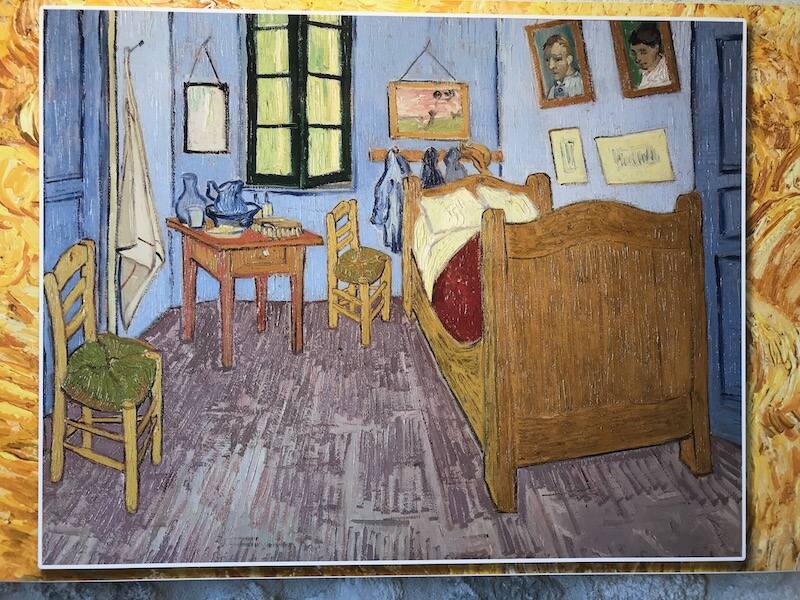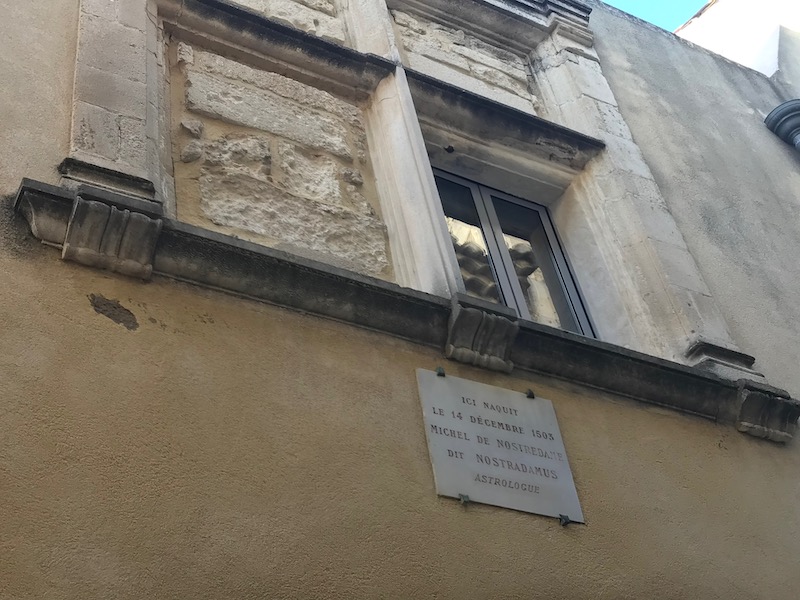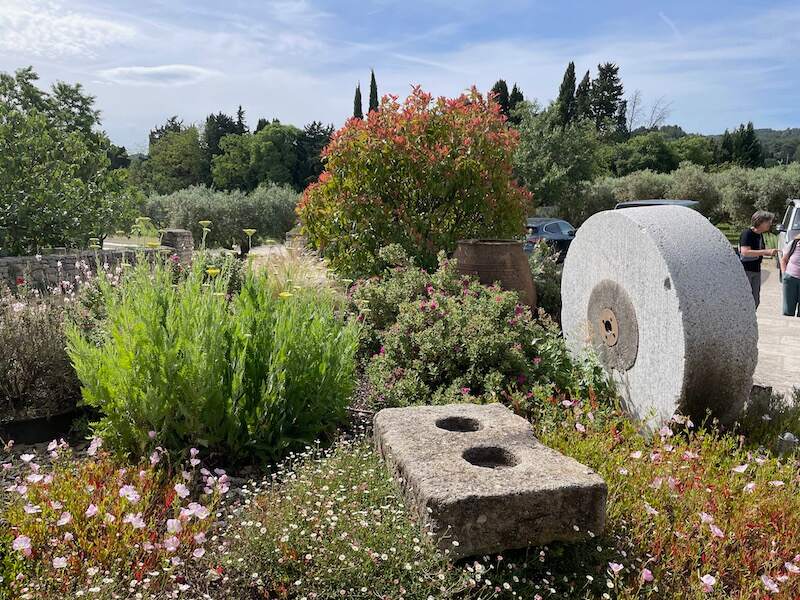Unsure about your French table manners? Click Here to download > > How to avoid these 10 food etiquette mistakes !
- Home ›
- Destinations ›
- Southern France ›
- Saint Remy de Provence
Don't Miss These 7 Spectacular Sights in Saint Remy de Provence
Published 14 August 2024 by Leyla Alyanak — Parisian by birth, Lyonnaise by adoption, historian by passion
Saint Remy de Provence, in the heart of Provence, is known for its Roman ruins and for Vincent van Gogh: he here created over 150 paintings. On my latest visit I was also able to visit the birthplace of Nostradamus, the famous seer on whom Catherine de Medici depended during the Renaissance.
In the rolling hills of Provence in southern France, where the Alpilles rise from the plains and olive orchards, the town of Saint-Remy de Provence reminds us that art and history are just as much a part of Provençal tranquility as are medieval streets and shady squares.
NOTE: Pages on this site may contain affiliate links, which support this site. See full Privacy Policy here.
Saint-Remy-de-Provence, also written Saint Rémy de Provence (with and without the hyphens and the accent) or St Rémy for short, delivers some fabulous Roman ruins and an idyllic setting for fans of Van Gogh, making it an essential stop on your South of France road trip or visit.
4 Key sights on Saint-Remy’s outskirts
My preference is to start the morning with the sights away from the center and then return to explore Saint-Remy proper after lunch.
It means I avoid walking up to the ruins in the sun during the hottest part of the day, and the morning's exploration puts me into the perfect frame of mind for an afternoon visit of the town. Of course, you can turn this upside down and start wherever you want!
I begin my day with a walk away from the center of Saint-Remy around 8:30am, and follow the Van Gogh trail for an hour. Filled with his artistry, I then enter Saint-Paul-de-Mausole, the asylum where he sought refuge and found so much creativity.
Having quenched my thirst for Van Gogh, I then turn my attention to the Romans by starting at Les Antiques (it never closes), across the main road from the asylum. And then, it's time to visit the archaeological site of Glanum and spend some time among the Romans.
All this can be done on foot, although you can drive to the ruins if you prefer – there's plenty of parking. If you do that, though, you'll miss several of the explanatory panels along the Van Gogh trail, but there are quite a few at the asylum, so you'll at least see some.
1. Walking with Van Gogh
A good place to start the Van Gogh trail is at the Saint-Remy tourist office, where you can pick up a map of the trail with all the stops included.
It’s only about a 20-minute walk, but that’s if you don’t stop to read each of the 19 panels. You most probably will, since the point of the panels is to explain what Van Gogh himself might have been seeing as a painter. I would give the walk about an hour.
The trail ends at Saint-Paul-de-Mausole, where Van Gogh sought refuge after going through a tumultuous period in Arles (remember the cut ear incident?)

2. Saint Paul de Mausole: Van Gogh's sanctuary
Perhaps the most famous chapter in Saint-Rémy's modern history began in 1889, when Vincent van Gogh admitted himself to Saint-Paul-de-Mausole, where he would create over 150 paintings, including some of his most famous.
During his year-long stay at the asylum, Van Gogh alternated between periods of lucidity and intense emotional turmoil. Yet it would still turn out to be one of the most productive and creative periods of his life.
His masterpieces from this time include "The Starry Night," which shows a swirling night sky over a quiet town, and "Irises," inspired by the asylum's garden. Whenever he left the asylum to paint around the countryside, more inspiration would come, as it did in his "Wheat Field with Cypresses" paintings, their sweeping fields and towering cypresses so typical of Provence’s landscape.



Inside the asylum (which still functions, by the way) you'll see a re-creation of Van Gogh's modest bedroom; his was not a life of luxury.



The cloister and chapel, tranquil spaces where he found solace, are also open to visitors, as are the gardens which so inspired him.

Outside the asylum, dotted throughout the fields, artists work to recapture the essence of Van Gogh and see the beautiful view and landscape from his perspective.

3. Les Antiques
Just outside the asylum, heading along the drive towards the main road, cross the street and you’ll come face-to-face with two magnificent Roman ruins, the Triumphal Arch and the Mausoleum of the Julii.
The two structures celebrate Roman victories and important citizens, and singled out the entrance to Glanum near the Via Domitia, France's oldest road, which once linked Italy to Spain through Provence.
The Mausoleum of the Julii, erected around 40 BCE, honors the prominent Julii family of the ancient city of Glanum (more about Glanum in a minute).

This majestic structure rests on a columned base with a frieze filled with battle scenes and mythological figures.
Above the base, a square podium with four Corinthian columns leads to ana carved archway, crowned with a sculpted pediment (see below) showing a hunt scene. On top is a smaller cylindrical chamber with statues of the deceased, a symbol of reverence for the afterlife.

Next to the mausoleum is the Triumphal Arch, which once marked the northern entrance to Glanum and celebrated the town's integration into the Roman Empire.
The keystone features an elaborate figure, probably Victory or a Roman deity, with intricate reliefs of captives in chains, symbolizing Roman conquest and power.
Together, these ancient monuments not only served practical purposes but also trumpeted Roman engineering and imperial ideology.
And now for the pièce de résistance…
4. Glanum
While the two monuments that make up Les Antiques have always been there, the ruins of Glanum were only uncovered in 1921.
Glanum was founded in the 6th century BCE by the Celts. Its strategic location near a vital spring attracted settlers, and it flourished under Greek influence before being conquered by the Romans in 27 BCE. With the arrival and victory of Julius Caesar in the region, the Romans transformed Glanum into a bustling and sophisticated city.
The sacred spring is revered for its healing properties. It drew settlers to the area and all around it, you can see what's left of the altars and temples dedicated to various deities.

Glanum's residential neighborhood once had luxurious Roman houses for its sophisticated inhabitants, with intricate mosaics, courtyards, and well-planned living spaces.
The public baths, essential to Roman social life, are examples of their advanced engineering, with their heating systems and separate bathing areas.
The forum, the city's political and social hub, was surrounded by administrative buildings and temples, a bustling center of commerce and administration.
Glanum once had defensive walls and gates, reflecting its strategic importance. Here are some photographs I took of what's left of the Roman city.



 The old Greco-Roman ruins of Glanum ©OffbeatFrance
The old Greco-Roman ruins of Glanum ©OffbeatFranceGlanum has a typical roman grid pattern of streets, public spaces, and a proper infrastructure.
The ruins of shops, homes, and public buildings provide a peek into daily life, and artifacts such as pottery, tools, and coins connect the city to its past. The remains of temples, altars, and religious items highlight the importance of religion in Roman life.
This was a town with a thriving economy. It addition to its man shops and stalls, the fertile lands of Provence supported agriculture, providing food and resources for Glanum's population.
The Roman Empire declined, and Glanum was abandoned in the 3rd century CE due to barbarian invasions. Its inhabitants moved to a nearby hill, where they established what is now Saint-Rémy-de-Provence.
During the Middle Ages, the town grew around a Benedictine abbey, Saint-Rémy, which lent the town its name.
If you enjoy Roman ruins, Glanum is a spectacular site, of which I wish much more had survived. Make sure you spend at least an hour here, and if this is a holiday or vacation time, get your ticket beforehand to avoid the lines to visit this ancient Roman city.
…and 3 essential things to do inside town
Now that you’ve seen what the outskirts have to offer, it’s time to head into St Rémy to enjoy the town’s welcoming vibe and meandering streets.
5. Roam around town
Walking around medieval towns, especially if they happen to be in Provence, is surely one of life’s more pleasurable activities.
Try to aim for the Wednesday morning weekly market, with its cheerful Provençal textiles and mountains of soaps and olives (and make sure you get there early, before the crowds). Keep getting drawn in by the enticing scents of lavender and walk away with a bunch.
On summer Sundays, visit La Route des Artistes, an outdoor contemporary art exhibitions, where artists show their works along the boulevards that surround the historic center.
Meander among the old fountains and drop into one of the many art galleries, looking for that special spot or purchase.
 Town hall of Saint-Rémy ©OffbeatFrance
Town hall of Saint-Rémy ©OffbeatFranceTake advantage of being in this part of France to visit a flea market if there is one that day (the tourist office will know) or taste some local foods of Provence − dishes like ratatouille (a vegetable stew) or anything “à la Provençale”. If you’re picnicking, grab a pissaladière, a melt-in-your-mouth onion tart with anchovies and olives.
There are plenty of wines locals pair with the region’s wonderfully sunny cuisine, especially its cool, crisp rosés.
6. Visit the Musée d’Estrine
Take a bit of time to visit the Estrine Museum, housed in an elegant 18th-century mansion.
It celebrates the work of Vincent van Gogh with reproductions of paintings he created while in Saint-Remy, along with several exhibits that explore his techniques, his evolution, and his thoughts and struggles during his time here.
The museum also houses a Provençal art collection, with works from several prominent local artists − Charles Camoin, Auguste Chabaud, and André Marchand − who were hugely influenced by their region’s landscape and light. How could they not be!
7. Pay homage to the birthplace of Nostradamus
Nostradamus, or Michel de Nostredame, is one of the most influential seers of all time, famous for the 942 predictions in his book, Les Prophéties, or The Prophecies.
But these are written in obscure poetic quatrains that people still can’t interpret to everyone’s satisfaction.
Catherine de Medici, wife and mother of kings, relied on him heavily, inviting him to court and asking him to examine her royal children − and chart their horoscopes.
He was a medical doctor who made good by selling magic potions and publishing an annual almanac filled with predictions, a bit like the horoscope books we have today (or did, before everything went online). He based his predictions on those of other seers and on observing the skies, becoming a renowned astrologer.
To me, no visit to Saint-Remy would be complete without a walk past #6, rue Hoche, where the magus was born…
 This is the house in which Nostradamus was born, more than 500 years ago ©OffbeatFrance
This is the house in which Nostradamus was born, more than 500 years ago ©OffbeatFranceBonus sight: oil tasting in an olive mill
This isn’t exactly a sight but it’s certainly a worthwhile destination.
If you’re driving and are a fan of olive oil, stop by the Moulin du Calanquet just outside town.
This family-owned olive mill offers oil tastings (a lot more fun than I expected), explains the harvest and production processes if you’re interested, and of course sells plenty of its own products, which I’m still using several months after my latest visit. Drop them a line if you’d like a tour (they speak English) or just stop by to pick up a few goodies.
 I thoroughly enjoyed my olive oil tasting here − I had no idea olive oils could taste do different from one another ©OffbeatFrance
I thoroughly enjoyed my olive oil tasting here − I had no idea olive oils could taste do different from one another ©OffbeatFranceBest time to visit Saint Remy
Like most of France, visiting off-season or during the shoulder season is the most pleasant. Provence is hotter than the rest of France, and in summer, being out and about can be draining.
- Spring is mild and a time when everything is in bloom, so the scenery is at its best, as is the weather. In May, you can enjoy the Fête de la Transhumance, when shepherds bring down their flocks from their winter to summer pastures.
- Summer is perfect for festivals and markets, and of course, lavender fields. But it’s the peak tourist season, so in addition to the heat, expect crowds.
- Fall, like spring, is great weather-wise, and a good time to take part in wine-harvest related activities. And there are fewer crowds. But no lavender...
- Winter, which for some reason is my favorite season, is still mild compared to the rest of the country, and it’s the quietest time of year (and prices drop). The downside is that some things are closed or have shorter opening hours… but there’s still plenty to see and do.
Getting to Saint Remy en Provence and getting around
It’s extremely easy to reach if you’re driving: it’s a half-hour from Avignon, the City of the Popes and site of the famous Avignon Bridge; about 40 minutes from the antique shops of L’Isle-sur-la-Sorgue; and less than an hour from the hilltop villages of the Luberon.
IF YOU'RE PLANNING TO DRIVE IN FRANCE...
This online course is a quick and enjoyable way for you or your second driver to learn our driving rules. I live and drive in France, and even I learned things to make my road trips more enjoyable, safer and less stressful. Find out more here.
In town, walking is the best way to get around. Saint-Rémy is pedestrian-friendly and walkable and you won’t have to go far to explore its narrow streets.
Bike rentals are popular here, so that’s an option, including electric bikes should you prefer a “little help”.
There IS public transportation from nearby towns, but it’s not the most straightforward.
While I normally recommend a tour or two to visit places that are hard to reach by public transport, I have no tours I can recommend for an in-depth visit of Saint-Remy, since most will stop briefly and include plenty of other delightful venues − but not, in my opinion, enough time to see everything Saint-Remy has to offer.
If your time is limited and you’re up for seeing several sites in a day, then this tour from Avignon includes several outstanding sights, in addition to Saint-Remy.
Prefer to leave from Aix-en-Provence? Here you go!
And yes, you can also grab a Provence tour that starts out in Marseille.
Where to stay in Saint-Remy-de-Provence
I can recommend several hotels (or you can browse hotels and apartments from the map below) but a word of warning: although Saint-Remy has plenty of hotels, these fill up quickly and are often not available, so please book well ahead of time if you know your travel dates.
Recommended accommodations
- I often prefer to stay in a “Mas”, or traditional country home. There are plenty of these within a stone’s throw of Saint-Remy but they go quickly. Just search for “mas” in Saint-Remy.
- Hotel Gounod is a mid-range hotel in the heart of Saint-Remy (with parking!)
- Saint-Remy has plenty of apartments and villas for a few nights (or longer).
- For a bit of luxury, head for Le Vallon de Valrugues & Spa, also within walking distance of the center of town.
Before you go…
Saint Remy de Provence is one of those towns worth the gift of time because there’s plenty to see, and it should be part of any road trip through southern France or if you’re headed to the Luberon, to Avignon and Nimes, or to Arles and the Camargue.
~All photos on this page, with the exception of Van Gogh's paintings, are ©OffbeatFrance/Leyla Alyanak
Did you enjoy this article? I'd love if you shared it!

